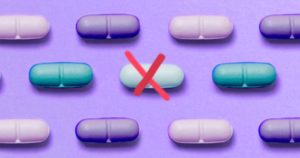Home remedies won’t clear up a yeast infection, but here’s what does
You may have heard that vaginal yeast infections are very common in women. In fact, three out of four will get at least one vaginal yeast infection in their lifetimes. When a yeast infection occurs, the most important question is how to quickly clear it up. Keep reading to learn about common yeast infection causes, why home remedies don’t work to treat yeast infections, and a convenient and effective online treatment option.
What causes vaginal yeast infections?
We all naturally have many types of fungus that live in or on our bodies. But sometimes the fungus candida albicans grows too quickly, causing a yeast infection. Common causes of vaginal yeast infections include:
- Antibiotics — Antibiotics help wipe out infections by killing bacteria. But they can also kill beneficial bacteria, allowing yeast to grow unchecked.
- Hormone changes — Hormonal shifts experienced during menstruation, pregnancy or when starting a new hormonal birth control method can disrupt the vaginal microbiome and lead to yeast infections.
- Uncontrolled diabetes — Yeast feeds on sugar, and if blood sugar levels are too high for too long, a yeast infection may follow.
- Certain spermicides or lubricants — Some women experience a reaction to ingredients in spermicides and lubricants, causing irritation and imbalances in the vagina that can spur a yeast infection.
- Certain clothing, underwear or swimwear — Certain types of fabric or damp or wet clothing can trap moisture in the genital area and create an environment where yeast thrives and grows.

Yeast infections aren’t contagious and can’t be passed between sexual partners. But having sex can change the vaginal microbiome and trigger an overgrowth of yeast, which may lead to a yeast infection.
What are the symptoms of a yeast infection?
When something feels “off” with your vagina, it’s important to pay attention and seek answers and treatment. Yeast infection symptoms can vary from person to person and even infection to infection, and may include:
- Vaginal itching
- Thick, white and curd-like vaginal discharge
- Vaginal irritation and inflammation
- Vaginal burning and discomfort, especially during urination or sex
- Vaginal redness and swelling
- Vaginal discomfort and soreness
Home remedies for vaginal yeast infections
Yeast infection symptoms can be really uncomfortable, and it’s no wonder that many women turn to the internet to find quick ways to feel better. But home remedies like yogurt or other probiotic-rich foods, boric acid, douching and essential oils aren’t effective and can cause more irritation and discomfort.
Douching
Douching involves washing the inside of the vagina, typically using a special high-pressure bottle and water or other solution. But clinicians don’t recommend douching as it can create imbalances in the vaginal flora and contribute to vaginal irritation and infections, including yeast infections.
Probiotics
While probiotic-rich foods like yogurt have been proven to help promote gut health, there’s little evidence to support that they positively affect the vaginal microbiome. And products like oral probiotics and suppositories will not kill candida albicans or clear up a yeast infection.
Essential oils
Essential oils like tea tree and oregano are sometimes touted as yeast infection treatments, but there is no conclusive evidence to support their effectiveness. And manually applying these types of oils can result in vaginal irritation and discomfort.
Fast and effective yeast infection treatment
Over-the-counter (OTC) yeast infection medications typically come in the form of creams and suppositories that must be used for several days and can be expensive and messy. Fortunately, there’s another option – the one-pill prescription antifungal treatment Diflucan or fluconazole. And you can get a prescription for Diflucan online at Virtuwell. Just answer a few questions about your symptoms and medical history, and a clinician will provide a personalized treatment plan and a prescription for the antifungal medication.
Preventing yeast infections?
Help keep yeast infections at bay with these yeast infection prevention tips.
Yeast infection prevention tips:
- Wear cotton underwear — Avoid silky and synthetic fabrics that can trap moisture.
- Avoid harsh chemicals, fragrances and detergents — The vagina is “self-cleaning.” To keep pH levels in balance, avoid using feminine washes, scented products or soaps on your vulva.
- Promptly change out of wet clothing — Change into dry clothes as quickly as possible after a gym session or swim.
- Only take antibiotics when necessary — Antibiotics can throw off your body’s natural balance, so it’s important to only take antibiotics when they are prescribed.
Vaginal symptoms like itching, soreness and thick discharge could indicate a yeast infection. Start a visit at Virtuwell and get a one-pill yeast infection prescription treatment today.
Share this post
Do you know someone who could use a simple & affordable healthcare option?

